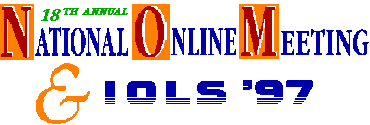
In competition for market share in large markets, beyond the reach of sales forces and traditional business and trade marketing practices, brand names have always been critical. Most of the owners of significant brands in the business of "digital publishing" are owned by publishers--Thomson, Reed-Elsevier, Dow Jones, McGraw-Hill, Wolters-Kluwer, Pearson, and others. Large newcomers like Microsoft, IBM/Lotus, Netscape, Bloomberg, and America Online, and small ones like Individual, Inc. and Desktop Data, still are evolving. Most of them have licensed material from publishers as a part of their development, and some are producing their own editorial content. Meanwhile, dozens of new Web publishers appear on the scene monthly, challenging established publishing brands with low prices or creative presentations. What will "readers" do? And, perhaps more importantly, what will advertisers do? New users continue to enter the market at a staggering pace, and Internet service providers' services are struggling to keep up. While there are many uncertainties, one consequence of the rapid growth in users is that the market is fragmenting, with segmentation around functions, industries, activities, and interests.
Segmentation-fragmentation means that traditional mechanisms of the online business, such as the extensive direct mail programs of AOL and its counterparts, cannot possibly address all of the increasingly varied interests of the growing number of electronic "readers."
This year's program will address the role of publishing brand names on the World Wide Web, their value, and their future. During the morning session, owners of brand names--new and old--will be asked to explain their strategies for transition to this evolving environment.
During the afternoon, we will provide information that will help the
audience judge the viability of brand names in the evolving networked
environment. Speakers will address some key trends in this environment,
including advertising, pricing, customer support, the current state of
disintermediation, and other elements that may affect success or
failure. At the end of the day, a panel will discuss the rationale for
winning and losing strategies. As always, the audience will be expected
to join in to corroborate or challenge the views presented.
CD-ROM drives can be placed on networks by creating dedicated CD-ROM servers and/or attaching drives directly to a file server. Performance, cost, and maintenance issues will be explored for each approach. Tips on how to get the best performance from a server will also be provided.
Menuing, metering, usage tracking, and application time-out functionality should be part of any CD-ROM network design. Products which provide these management features will be identified. A Windows user's ability to open several CD-ROM databases at a time can defeat your attempts to manage a limited number of network licenses. Howard will present options for managing multi-tasking clients.
Many organizations have hundreds of CD-ROMs they'd like to share with the entire organization. Jukeboxes do not provide on-line (immediate) access--they are near-line storage devices. Howard will discuss when and how to use jukeboxes and will provide system designs which will support large collections and document delivery systems. Users at home or in branch offices, executives on-the-road, and an increasing number of professionals share one thing in common--they are not always directly connected to the organization's network when they need information. With the use of Remote Control Communications Software (RCCS) and high-speed modems, dial-in technologies can provide access to CD-ROM databases. Various methods for implementing host communication servers for access by a variety of clients (DOS, Windows, Mac, etc.) will be presented and demonstrated.
Howard will also present designs for linking remote users and entire remote LANs directly to the central CD-ROM site. WAN links are generally 56K or less and cannot handle the volume of data created by CD-ROM searches. Bandwidth-efficient Client/ Server options will be addressed as a means to share resources over WAN links.
Because of the nature of the technology (audio-based), a CD-ROM drive can still only support 6-8 users at the same time. Howard will present a model that significantly improves performance to accommodate 30-40 simultaneous users. True client-server database solutions will be demonstrated where the databases are virtually-mounted off-site.
In most organizations, the Intranet is where the action is. Howard will present a case study for launching DOS and Windows CD-ROM databases from a Web page. Winframe and NTrigue technologies and issues will be discussed as they relate to enterprise-delivery of CD-ROMs through hyperlinks to a variety of clients, including Windows, Macintosh and X-Windows.
Suggested Background Knowledge for Attendees
Learn how to compare and evaluate sources of information and how to decide which is best--using specific criteria. This seminar includes a feature-by-feature comparison of major online services for the professional searcher. The 100-page course manual includes a comparison overview for future reference.
This very popular course is offered through The Information Professionals Institute and is designed to cut across vendor and commercial lines. It combines the perspective of Ms. Burwell's experience with timely, state-of-the-art research information.
The workshop was developed by Carol K. Galvin, market research specialist for Lotus Development Corporation, and Barbie E. Keiser, Director of the Kathryn and Shelby Cullom Davis Library of The College of Insurance. The combination of market researcher and information professional yields a focus and perspective that enhance the subject material. Both are accomplished authors of articles in the information and business press, and speakers/presenters at information and business conferences around the world. The two collaborated once before as co-authors of Marketing Library Services: A Nuts-and-Bolts Approach, turning the text into a successful workshop. The book, in its second printing, was recently reissued by the Federation of Information and Documentation (FID).
Ms. Corcoran was a marketing and sales executive with Knight-Ridder Information for 15 years prior to the launch of her new company this year. She holds a master's in library science from Columbia University and worked as a practicing information center manager for 8 years. She also holds a BA, summa cum laude, in history from St. Louis University. She's a frequent speaker and facilitator at information conferences and events.